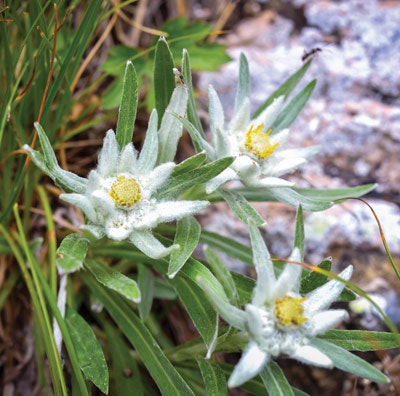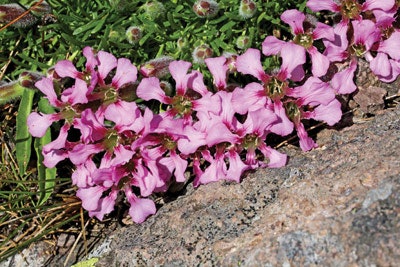
Sometimes in life, you get what you get, so you might as well make the most of it. If Aunt Molly knits you an ugly sweater for your birthday, you put it on and wear it proudly knowing she put her heart into it. And ultimately, it keeps you warm. This is how you might picture the life of a mountaintop extremophile—minus the sweater.
Extremophiles are organisms that thrive under the worst conditions on Earth. Interestingly, the term extremophile comes from the Latin extremus, meaning “extreme,” and Greek philiā, meaning “love.” There’s no doubt, they hold something deep down inside that helps them not only to survive, but to flourish. And science has unraveled some of these survival mysteries to benefit skin care.
There are several extremophile types:1
- Thermophiles are heat-loving, and found in environments like deep sea vents, volcanic soil and around geysers.
- Psychrophiles, also known as cryophiles, are the opposite. Adapted to cold, they live in places like polar seas.
- Halophiles thrive in high salt conditions like brine, and may be found in salt flats or lakes.
- Acidophiles, as you might expect, are adapted to very acidic conditions, such as volcanic landscapes.
- And organisms adapted to multiple extreme conditions are referred to as polyextremophiles.
Considering we’re in the midst of surviving bitter winter conditions, let’s take a closer look at the cryophiles—especially those adapted to Alpine mountain landscapes.
Edelweiss
 The white edelweiss or Leontopodium alpinum flower is a national symbol in Austria, Switzerland and other countries in the Alps. It grows at high altitudes (6,000-10,000 ft), mostly in limestone where UV exposure is high and temperatures are very cold. This makes edelweiss an expert at protection, and it can bring some of that expertise to the skin.
The white edelweiss or Leontopodium alpinum flower is a national symbol in Austria, Switzerland and other countries in the Alps. It grows at high altitudes (6,000-10,000 ft), mostly in limestone where UV exposure is high and temperatures are very cold. This makes edelweiss an expert at protection, and it can bring some of that expertise to the skin.The edelweiss plant contains tannins, flavonoids, phenylpropane and hydroxy cinnamic acid derivatives. It also holds volatile compounds such as hexenyl acetate, lime, pinene and coumarin. These have astringent, anti-inflammatory, analgesic and antioxidant properties.
Edelweiss additionally helps to strengthen the skin barrier, balancing skin and providing moisture. It stimulates genes and proteins responsible for epidermal protection including transglutaminase 1, involucrin, loricrin and keratins. This improves skin barrier integrity and stratum corneum cohesion, leading to better protected, more resistant skin. As a consequence, the skin is more relaxed and less sensitive, giving an ultimate sensation of skin comfort.
It also confers its strong free-radical scavenging capabilities to fight the effects of UV exposure, protecting DNA and rebalancing UV-induced pro-inflammatory stress markers on the gene level.
Saponaria pumila
 Another Alpine extremophile is Saponaria pumila. This flower survived the last Ice Age by growing on ice-free mountain peaks, known as Nunataks. The survival instincts of this plant are preserved in its stem cells, which are prepared in liposomes for applications in skin care.
Another Alpine extremophile is Saponaria pumila. This flower survived the last Ice Age by growing on ice-free mountain peaks, known as Nunataks. The survival instincts of this plant are preserved in its stem cells, which are prepared in liposomes for applications in skin care.The stem cell extract of this flower has been shown to protect and maintain the functioning of human dermal stem cells against UV- and visible light-induced stress. It also enhances the formation and proliferation of dermal stem cells, maintaining their renewal potential despite environmental stress.
This, in turn, helps to re-densify the skin matrix. A study of 20 women between the ages of 44 and 59 with sun damaged skin who used the extract found their skin condition improved by almost 10% in just four weeks.
Snow Algae
Snow algae (Coenochloris signiensis) is another great survival strategist. This single-cell alga grows in Alpine or polar permafrost climates. Typically green in color, the algae turns red in early summer when it produces more carotenoid pigments due to increased UV radiation. It also produces secondary metabolites such as biopolymers, antifreeze glycoproteins, stress modifiers and osmotically active amino acids and sugars to survive in this habitat.
When used in personal care, snow algae powder stimulates the longevity gene, Klotho, and activates AMPK, a “master switch” in the cellular defense and energy system. This ingredient visibly improves skin structure, evens out skin tone and reinforces the skin’s barrier function through various mechanisms, including anti-matrix metalloproteinase (MMP) effects and rejuvenation of the dermal-epidermal junction. It also imparts smoothing and moisturizing effects.
Extremophiles in the Spa
Cryophiles have brought their skin benefits to the skin, largely for anti-aging and protection benefits.
Edelweiss. Hydropeptide uses edelweiss in its Hydrostem+6 to guard against free radical damage and create more radiant, youthful skin. GlyMed Plus also uses edelweiss in its DNA Reset Face & Neck Cream to prevent against the formation of wrinkles. The edelweiss plant stem cells contained in the cream contain adaptogens that help the body adapt to internal and external stressers. The ingredient is said to block involuntary muscle contractions that lead to wrinkle formation.
Dermaquest also uses edelweiss for its anti-aging benefits in a few of its products including its Stem Cell 3D Tinted Moisturizer, where it is combined with jasmine and gardenia stem cells to rejuvenate skin and reduce the appearance of wrinkles.
DermAware uses edelweiss along with licorice, chamomile and calendula to reduce sensitivity in its Vital K Microgel. Gül Zone, CEO and founder of DermAware added, “Rich in the polyphenol chlorogenic acid, [edelweiss] provides strong antioxidant and anti-inflammatory protection. This anti-inflammatory effect is boosted with two additional inherent compounds: luteolin and bisabolenes. Luteolin, a flavonoid, also increases hyaluronic acid.”
Similarly, PureErb formulates with edelweiss in its Bulgarian Rose Soothing Toner to soothe and soften sensitive skin. Janel Luu, CEO of Le Mieux and PurErb, noted “Edelweiss may look like a tiny delicate plant, but the actives that the plant uses to protect itself from its harsh native environment can be a powerful addition to your anti-aging skincare arsenal. Its actives contain superior levels of leontopodic acids A and B as well as 3,5-dicaffeoylquinic acids to help protect against free radical damage; amino acids to help promote the synthesis of collagen and elastin; polysaccharides to help the skin retain water and prevent loss of elasticity; and phytosterols to help prevent collagen breakdown and encourage collagen production.”
Ice Age plant. The stem cell extract of Saponaria pumila was only recently launched; therefore, it is not yet proliferated in spa skin care. However, it has recently made its way into the new Bio-Firm Hydrogel Concentrate from MyChelle Dermaceuticals, where it helps to improve skin elasticity and firmness by protecting and vitalizing dermal stem cells while fortifying the skin’s self-defense activities.
Snow Algae. Snow algae definitely has risen in the ranks as an anti-aging ingredient in spa skin care. Éminence uses the ingredient in its recently launched Firm Skin Targeted Treatment to control the visible signs of aging. Boldijarre Koronczay, president of Éminence, explained, “Snow algae is a used to repair and rejuvenate skin at the cellular level. Due to its unique ability to thrive in freezing temperatures and defend against UV-induced damage, this potent ingredient also contains compounds that protect skin against environmental aging and transepidermal water loss, even in extreme weather conditions.” Circadia has also recently launched a product with snow algae, its Snow Algae and Spiruline Cooling Mask, where it protects the cells while helping to repair them. Its use leads to improved cellular defenses, oxidative stress resistance, cell detoxification and repair. G.M. Collin also uses snow algae in its Diamond Serum to rejuvenate skin.
Conclusions
So the next time you’re scaling snow-encrusted slopes, take a page from the extremophiles. Apply their techniques topically, to protect your skin, and crawl into that ugly sweater as your very own empowered extremophile, adapting to flourish in your environment.
REFERENCES










